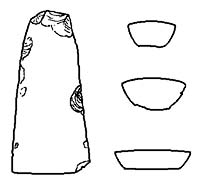INDEX********************TUBUAI******************** next page
ARCHEOLOGICAL EXPLORATION AND INVENTORY
with related research in the field of
COMPARATIVE IMPLEMENTOLOGY
VOLUME 18
Rendezvous with Helen Leach in Tahiti
*****Helen Leach is one of the worlds few specialist experts in the realm of Polynesian stone tools, and her expertise in the lithic processes by which adzes are fashioned is perhaps second to none. Her research into the manufacturing processes has allowed her to develop a system of classification which is based on the number of lateral edges from which trimming blows are struck (quadrilateral, trilateral, or bilateral).
*****Over the last two years we had been communicating by letter but now at last we meet in person and have the opportunity to explore together some of the important adzes in storage in the Museum (Musee de Tahiti et des Iles). While I had managed previously to examine a good many of the adzes in storage, it was important to review certain specimens which may offer clues pertaining to the origins of the early East Polynesian Culture.
*****Helen was now just returning from Hawaii where, in the Bishop Museum she had the opportunity to examine some of the adzes excavated in the Marquesas by Y. H. Sinoto and Mari Mari Kellum, specifically the Hane adzes. Some of these adzes have found their way back to French Polynesia and now reside in the Museum Reserve.
The Hane Adzes
***** These adzes must be considered as some of the most important ever found, they are rare in as much as they come from known stratigraphic contexts. Some may be considered as being from the early settlement period and it is these which I hoped to question Helen about. Some of the dozen or so examples in the reserve appear well encrusted and may be early however they are registered with only a bare minimum of detail and without information concerning their stratigraphy (* now laterally reported as early, recorded by Green 1971, as being from the lower levels). They are however quite uniform in their characteristics, most appear to approximately conform to a basic reversed trapezoidal form. After considerable reflection I have selected one as being typical of the group, it is illustrated in Diagram 18.1.
********************
***** This form differs mainly in thickness from the typical "quadrangular" example illustrated by Sinoto (1968, 144, Figure 2, 1). It appears that these adzes vary considerably in thickness, the thickest approach a nearly triangular form (reversed), more pertinent however is the presence of pecking on many specimens, this is mainly restricted to the longitudinal butt margins which tends to round off the margins and surprisingly some of these appear similar to certain 2B forms such as the New Zealand examples, where pecking has been used for the same purpose. While Helen and I did not discuss this issue at length, it appears in retrospect rather odd.
*****The presence of such a large proportion of 2A adzes in the early Hane assemblage appears the first issue to address. Certainly it will be difficult to link these adzes to a Western source, while it would appear that they are a common early form in Eastern Polynesia. One large and exceptionally shallow example in the Museum collection has been fashioned from a suitably formed thin prismatic slab. One or two other shallow adzes in the collection may have also been manufactured from natural rock forms. This raises the issue of whether or not the proliferation of this adze form is in fact due to the early discovery of an abundance of suitable ready made blanks. An abundance available perhaps only in the Marquesas, for the form is rare in Western Polynesia.
Link to page 2**************file INDEX**********Artifact/Diagram INDEX
